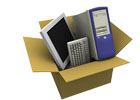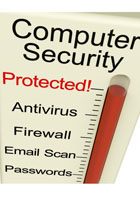

Resource FAQ
- What are signs my hard drive is failing?
- Your computer won't boot (other issues also prevent booting)
- You are having trouble accessing some data on your hard drive
- Some programs start up very slowly or never start, while others work normally
- Your hard drive is making a clicking or grinding noise
- Your software is displaying occasional error messages about read errors
- Computer slow to boot (There are other reasons for this as well)
Warning: If you suspect a failing hard drive, stop using it and call us before it fails completely. If you wait, then you may not have a chance to recover the data, or you may have to send it away to recovery specialists that will disassemble the drive and then extract all the data that is possible to recover, which is very expensive.
- Should I upgrade to Windows 7?
- We do not recommend upgrading existing computers from XP to Windows Vista. However if you are still using Windows XP, if your computer is capable of running Windows 7, then this is a good upgrade strategy. There is a tool avaialable from Microsoft that will scan your computer, and will inform you if there are any problems that would prevent you from upgrading to Windows 7. Many older computers will not be capable of Windows 7, and are even less likely to be capable of running Windows 8.1
- Can I get a deleted file back?
If the file is not in the recycle bin and not stored on a backup we may be able to recover it for you, if you follow the instructions below, but you must act immediately as the possibility of recovery diminishes rapidly if you continue to use the computer.
Often files can be recovered if you stop using the computer right away, as soon as you become aware that a critical file is missing. Our success depends how soon you detect the file is missing, and stop using the computer. For best results either unplug the Internet and stop using the computer or even better shut down the computer completely. Then give us a call.
More details about deleted file recovery are available here.
- How can you make my wireless network work better?
- We can do a site survey to pick the best channel to use.
- We set up solid security if you do not wish to share your connection with others. We would change WEP to WAP.
- We can set up your network to have 2 or 3 neighbours share the same Internet connection, with security so that no-one else can use it.
- We put in QOS rules to manage your bandwidth when required, using 3rd party firmware in a customizable router.
- We look for sources of interference, which may include microwave ovens, some cordless phones, hackers at work (a.k.a. play).
- We audit and setup share permissions on the computers inside your network to provide barriers to unauthorized wireless users getting into your computer.
- If required, install a repeater to increase your coverage area, if you have a large house or area to be covered.
- How do we recover files from a hard drive that is failing?
-
We boot Linux from a USB drive or CD-ROM, and use a raw disk copier program to copy the readable disk contents (sectors) to a 2nd new replacement drive that we have attached. The copier program will try very hard to read every sector using multiple passes. The first pass quickly gets the area of the disk that does not have errors. At the start of the error, it skips forward, then reads backwards to find the end of the group of errors, then carries on copying the areas of the disk that have no errors. It records each area it skips over, to try again in a future pass. After the first pass, the low hanging fruit has been picked. Next it revisits the areas where it previously found errors and does a sector by sector read with multiple retries to try to read more data, to try to recover data from the failing sectors. Once this process is done, the new disk is put in place of the failing one, and we boot from the new disk. Any missing or corrupted files are replaced, and hopefully your computer will be running with only a few files missing.
Does this always work?
No. Sometimes the user data is recovered, but the OS (Operating System i.e. Windows) does not boot. The operating system is not complete due to the errors in the area of the disk where the operating system is stored. In this case we either replace the missing files, or have to re-install the operating system. Since we do a re-install of the operating system, your data files are not lost, and you do not have to re-install all of your applications.
When should this be done?
ASAP, as the longer the failing drive is used, the worse it gets. When we do a recovery we quickly copy the error free parts of the disk first, and then work on the errored part as if expecting it to fail completely at any time. The longer you wait, usually the worse the problem becomes. Less and less files will be recoverable.
- How do I recover a deleted picture from my digital Camera?
- Nearly all camera flash cards use a FAT16 file system, very similar to that used on some Windows PCs. See our entry on recovering deleted files and read about FAT file systems. First you must stop using the card, that is stop taking pictures until the recovery is completed. You can download a utility from the Internet onto your computer and try to do it yourself, or you can ask us to do it. This is simpler since the camera's card is not a drive that is permanently mounted and used by Windows, and so it is safe to use your computer as a tool in the recovery.
- How do I back up my system?
- Visit our Backup Plan page for a variety of methods for doing backups.
- My computer failed to boot, what can I check?
-
DIY Checklist

- Is the power cord firmly plugged into the wall, and into the computer? If there are any lights on (LEDs) the computer is probably powered OK.
- Plug a lamp into the outlet and check that it lights up, to see if the outlet powering your computer is live.
- If you have a UPS or lightning surge protection power bar to protect your computer, plug the computer directly into the wall and see if it works.
- It the monitor switched on? If not it may look like it is not booting.
- Is there a CD into the CD-ROM drive? If so eject it.
- Is there a floppy in the floppy disk drive? If so eject it.
- If you have an external hard drive, and it is your primary drive (C:), make sure that it is powered up, and the cable to the computer is firmly seated at both ends. Try unplugging it and then re-inserting it.
- Is the computer booting, but you can't do anything. Unplug and then re plug the keyboard connector, and the mouse connector.
- If you have done all of the above checks, and the computer makes a couple of beeps after you turn it on, it does require service.
- My computer boots, but the mouse does not work! If it is a wireless mouse (no cables) then change the batteries and try again.
- If all of these do not help, unplug the computer's power cord from the wall, wait 15 seconds and then plug it in again. Then press the power button to start it up.
- If you see nothing on the monitor, but after much longer than it takes to boot you tap the "caps lock" key and the caps lock LED turns on and off each time you tap this key, the problem is probably in the display. If it is a CRT monitor (big, looks like a small TV) then your best solution is to buy a new LCD flat screen display. These days the CRT monitors are not cost effective to fix. You are better off to replace it.
If any of these tips helped, congratulations you have saved yourself a minimum charge service call cost. Please remember us in the future when you need help for a problem that you can't solve.
- What e-mail service do you recommend for new computer users?
- Gmail, by Google is our #1 recommendation for e-mail. It also happens to be free. We use it ourselves! Since surfing the Internet and using e-mail are the main uses for a computer by many people, it is best to start out with a good choice. We have created a detailed response to this question, which will probable include some extra information that you have not yet considered. It is a great choice for people who do not yet own a computer and use friends, family and library computers to access e-mail.
Read our detailed reasons for recommending Gmail as your e-mail service
- Why Can't I have the same view of e-mail on all my devices?
- Many people are frustrated with having a different set of e-mails stored, and marked as read or deleted on each device. The ideal experience is mail read on one device is marked read on all the others. Similarly deleting mail on one device will also delete it on all the other devices that access the same e-mail account.
The frustration is due to the use of the POP3 protocol, and there is a full solution. Read our detailed descriptions of the problems, and steps for solving this problem by using IMAP4 instead of POP3. Click to learn more about POP3 and IMAP protocols, and how changing to IMAP would solve this source of frustration.




